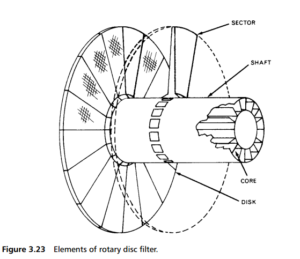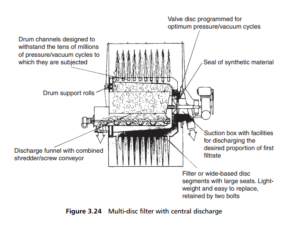0
-
An empty cart
You have no item in your shopping cart
envato-wordpress-toolkit domain was triggered too early. This is usually an indicator for some code in the plugin or theme running too early. Translations should be loaded at the init action or later. Please see Debugging in WordPress for more information. (This message was added in version 6.7.0.) in /var/www/wp-includes/functions.php on line 6121g5plus-darna domain was triggered too early. This is usually an indicator for some code in the plugin or theme running too early. Translations should be loaded at the init action or later. Please see Debugging in WordPress for more information. (This message was added in version 6.7.0.) in /var/www/wp-includes/functions.php on line 6121Rotary disc vacuum filters have the advantage, compared with rotary drum filters, of giving a much larger filter area per unit of floor area. They are thus particularly suitable for the processing of bulk products, for example in coal preparation, ore dressing, pulp and paper processing, and so on.
The principle of construction of a rotary disc vacuum filter is that a number of filter discs are mounted, parallel to one another, on a horizontal shaft. Each disc is made of interchangeable sectors covered with the filter medium, which can be
taken out for fitting and removing filter cloths. Conventional disc filters rotate the discs through a sump into which the suspension is fed. The sump will usually have an agitator to maintain constant suspension concentration, and therefore even cake formation. Vacuum is applied to the disc’ s sectors through pipes in the core of the central shaft, along which the filtrate is also removed ( Figure 3.23 ).

Cake collects on the submerged parts of each sector, and is removed from the suspension as the disc rotates. The cake is then treated as necessary, for example by washing, and is removed by washing or with a scraper just before re-entering the trough. In other designs, each disc rotates in its own narrow trough, effectively sub-dividing the filter into a number of individual cells. In this case agitation in the trough is not necessary, and the wetted area of disc can be greater (typically 50%
as opposed to 35 to 40% with an open trough). Also it is possible to isolate sets of troughs from one another so that two or more different products can be handled simultaneously by the same filter.
The filter area, and thus filtering capacity, of a rotary disc filter can be increased by increasing the number of discs in the complete unit. Standard units available may have from one to twelve or more discs, and tend to be made of plastic material. Each disc in turn may have up to 30 filter cells depending on the filter ’ s diameter. Drainage tubes are large and mounted outside the shaft.
A development of the rotary vacuum disc filter is equipped with a central discharge of the separated cake from the filter ( Figure 3.24 ). The discs are now mounted on the outside of an open rotor, inside which is a stationary trough, with a screw conveyor at the bottom of it. As the sectors pass through the feed trough, they accumulate cake in the normal way, but then this is blown off the discs at the top of their rotation, to fall through the openings in the rotor. This is an efficient design of filter, with greater effective submergence of the discs. This type of filter is not limited by maximum inlet consistencies: as long as the stock is fluidized then it can be processed by the unit. This allows applications not normally susceptible to vacuum disc filtration to be routinely handled.

For further information, please click here.